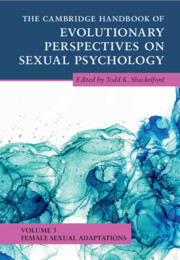Book contents
- The Cambridge Handbook of Evolutionary Perspectives on Sexual Psychology
- The Cambridge Handbook of Evolutionary Perspectives on Sexual Psychology
- Copyright page
- Contents
- Contributors
- Preface
- Part I Precopulatory Adaptations
- Part II Copulatory Adaptations
- 8 Sexual Fantasies
- 9 Copulatory Thrusting
- 10 Female Provision of Oral Sex
- 11 The Adaptive Value of Women’s Orgasm
- 12 Copulatory Urgency: An Evolutionary Perspective of Women’s Sexual Desire
- Part III Postcopulatory Adaptations
- Index
- References
11 - The Adaptive Value of Women’s Orgasm
from Part II - Copulatory Adaptations
Published online by Cambridge University Press: 30 June 2022
- The Cambridge Handbook of Evolutionary Perspectives on Sexual Psychology
- The Cambridge Handbook of Evolutionary Perspectives on Sexual Psychology
- Copyright page
- Contents
- Contributors
- Preface
- Part I Precopulatory Adaptations
- Part II Copulatory Adaptations
- 8 Sexual Fantasies
- 9 Copulatory Thrusting
- 10 Female Provision of Oral Sex
- 11 The Adaptive Value of Women’s Orgasm
- 12 Copulatory Urgency: An Evolutionary Perspective of Women’s Sexual Desire
- Part III Postcopulatory Adaptations
- Index
- References
Summary
Female sexual experience has received more attention from the scientific community in recent decades, but there is still debate surrounding its importance from an evolutionary perspective. Specifically, researchers have debated whether female orgasm is an adaptation reflecting special design or a functionless byproduct of strong selection for male orgasm that arises in women because of early shared ontogeny with men. Scholars who endorse a byproduct explanation of women’s orgasm argue that it is unlikely the female orgasm was designed by sexual selection because, unlike male orgasm, women’s orgasm is not necessary for conception. Supporters of the byproduct position further contend that an adaptive explanation of women’s orgasm is unlikely because orgasm is more difficult to induce in women compared to men and because women’s orgasm is more likely to occur during masturbation or oral sex than it is during vaginal intercourse. In other words, proponents of the byproduct explanation for female orgasm liken female orgasm to male nipples: something that offers no adaptive function and is vestigial, but that arises because selection for that trait is so strong in the opposite-sex that the shared early stages of development lead to it appearing in both sexes. However, there is considerable evidence that female orgasm is far from vestigial and may have increased the reproductive success of ancestral women. Researchers who support the adaptation explanation of women’s orgasm dispute the byproduct hypothesis by pointing to evidence that female orgasm increases women’s fitness through one or more mechanisms. Female orgasm reinforces and rewards women’s sexual behaviors, thereby encouraging women to engage in behaviors that can result in conception. Also, evidence suggests that women’s orgasm may reinforce or increase pair-bonding among couples, act as a mate- or sire-selection mechanism, and increase the odds of conception. This chapter reviews the literature on women’s orgasm and concludes that a byproduct account is an inadequate explanation of the current findings, although additional research into the evolved functions of women’s orgasm is nonetheless warranted.
- Type
- Chapter
- Information
- Publisher: Cambridge University PressPrint publication year: 2022
References
- 1
- Cited by



